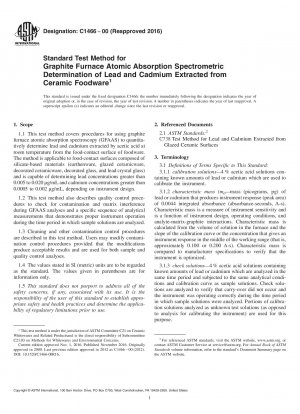ASTM C1466-00(2016)
Standard Test Method for Graphite Furnace Atomic Absorption Spectrometric Determination of Lead and Cadmium Extracted from Ceramic Foodware
- Standard No.
- ASTM C1466-00(2016)
- Release Date
- 2000
- Published By
- American Society for Testing and Materials (ASTM)
- Status
- Replace By
- ASTM C1466-00(2020)
- Latest
- ASTM C1466-00(2020)
- Scope
5.1 Toxic effects of lead and cadmium are well known and release of these elements from foodware is regulated by many countries. Regulatory decisions are based on results of 24-h leaching with acetic acid because results of this test method are precise and accurate and this test method is easy to use. Concentrations of lead and cadmium extracted by food may be different from results of this method, however, because acidity, contact time, and temperature typical of consumer use are different from those of this test method.
5.2 This test method is intended for application only in contamination-free settings and should be performed by well-qualified technical personnel. It is recognized that it is not a practical or appropriate method to use in a nonlaboratory environment for quality assurance and control of the ceramic process. Users are advised to use Test Method C738 (flame AAS) for purposes of the latter.
1.1 This test method covers procedures for using graphite furnace atomic absorption spectroscopy (GFAAS) to quantitatively determine lead and cadmium extracted by acetic acid at room temperature from the food-contact surface of foodware. The method is applicable to food-contact surfaces composed of silicate-based materials (earthenware, glazed ceramicware, decorated ceramicware, decorated glass, and lead crystal glass) and is capable of determining lead concentrations greater than 0.005 to 0.020 μg/mL and cadmium concentrations greater than 0.0005 to 0.002 μg/mL, depending on instrument design.
1.2 This test method also describes quality control procedures to check for contamination and matrix interference during GFAAS analyses and a specific sequence of analytical measurements that demonstrates proper instrument operation during the time period in which sample solutions are analyzed.
1.3 Cleaning and other contamination control procedures are described in this test method. Users may modify contamination control procedures provided that the modifications produce acceptable results and are used for both sample and quality control analyses.
1.4 The values stated in SI (metric) units are to be regarded as the standard. The values given in parentheses are for information only.
1.5 This standard does not purport to address all of the safety concerns, if any, associated with its use. It is the responsibility of the user of this standard to establish appropriate safety and health practices and determine the applicability of regulatory limitations prior to use.
ASTM C1466-00(2016) Referenced Document
- ASTM C738 Standard Test Method for Lead and Cadmium Extracted from Glazed Ceramic Surfaces*, 2024-04-20 Update
ASTM C1466-00(2016) history
- 2020 ASTM C1466-00(2020) Standard Test Method for Graphite Furnace Atomic Absorption Spectrometric Determination of Lead and Cadmium Extracted From Ceramic Foodware
- 2000 ASTM C1466-00(2016) Standard Test Method for Graphite Furnace Atomic Absorption Spectrometric Determination of Lead and Cadmium Extracted from Ceramic Foodware
- 2000 ASTM C1466-00(2012) Standard Test Method for Graphite Furnace Atomic Absorption Spectrometric Determination of Lead and Cadmium Extracted from Ceramic Foodware
- 2007 ASTM C1466-00(2007) Standard Test Method for Graphite Furnace Atomic Absorption Spectrometric Determination of Lead and Cadmium Extracted from Ceramic Foodware
- 2000 ASTM C1466-00 Standard Test Method for Graphite Furnace Atomic Absorption Spectrometric Determination of Lead and Cadmium Extracted from Ceramic Foodware
